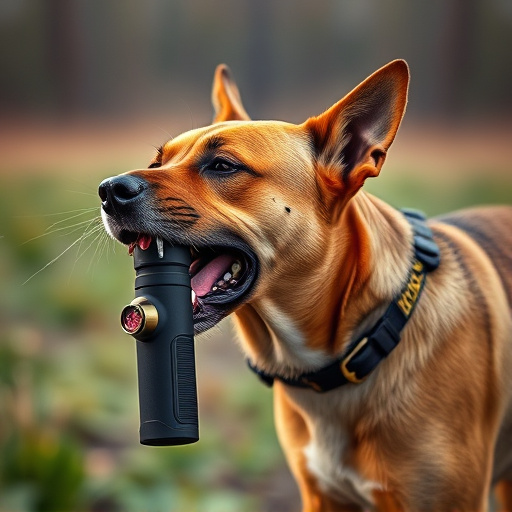Dog spray (self-defense spray for pets) is a legal and non-lethal tool to protect pets from aggression, governed by local Self Defense Spray Regulations. These regulations vary across regions, impacting possession, use, labeling, and product ingredients like capsaicin. Pet owners should understand these rules to ensure safe usage during walks or outdoor activities, selecting approved, potent yet controlled products for their furry friends' protection in public spaces.
“In today’s world, ensuring the safety of your pets is paramount. One effective tool gaining traction is self-defense spray designed specifically for dogs. This comprehensive guide, ‘Dog Spray: Safe and Effective Deterrent,’ explores the intricacies of dog spray as a pet safety measure. From understanding its mechanisms to navigating the regulatory landscape, we delve into how these sprays can deter potential threats. Learn about the factors to consider when choosing the right dog spray, ensuring both effectiveness and your pets’ well-being, while also adhering to local self-defense spray regulations for pets.”
- Understanding Dog Spray: A Comprehensive Overview
- The Role of Self-Defense Spray in Pet Safety
- Regulatory Landscape: Legal Considerations for Dog Spray
- Effective Deterrents: Choosing the Right Dog Spray for Your Pets' Protection
Understanding Dog Spray: A Comprehensive Overview
Dog spray, also known as self-defense spray for pets, is a specialized product designed to protect your four-legged friends from potential threats. It’s more than just a deterrent; it offers an effective way to manage and control aggressive dogs, providing peace of mind during walks or in unfamiliar territories. These sprays are typically legal in many regions, subject to local regulations on self-defense tools, and are especially valuable for pet owners dealing with aggressive canine behavior.
Understanding the mechanics behind dog spray is crucial. It’s usually a non-lethal aerosol that releases a powerful scent or mist designed to temporarily incapacitate or deter an attacking dog. The active ingredients can vary, but they are formulated to cause discomfort without causing serious harm. This makes it a safer alternative to other self-defense measures for pets, especially when considering the well-being of both the animal and potential attackers. Regulations around pet spray usage vary by location, so pet owners should stay informed about local laws regarding self-defense sprays for their furry companions.
The Role of Self-Defense Spray in Pet Safety
Self-defense spray, also known as pepper spray, plays a significant role in pet safety, especially for dogs. While it is primarily used by humans for personal protection against potential assailants, it can be an effective deterrent when it comes to safeguarding pets from dangerous situations. In many regions, self-defense spray for personal use is regulated and legal, with specific rules regarding the type of spray allowed and its permissible applications. These regulations ensure that individuals have access to a safe and controlled means of protection while promoting responsible usage.
For pet owners, considering self-defense spray as an option can be life-saving. It can deter potential threats like aggressive animals or even help in managing volatile situations during walks or outdoor activities. However, it’s crucial to understand and adhere to local Self Defense Spray Regulations when using such products for pets to avoid any legal complications and ensure the safety of both your pet and others around them.
Regulatory Landscape: Legal Considerations for Dog Spray
The regulatory landscape surrounding self-defense sprays, including dog spray, varies significantly across different regions. This diversity in regulations reflects a delicate balance between ensuring public safety and recognizing the unique needs of pet owners for effective deterrents. Legal considerations for dog spray often include restrictions on who can possess it, where it can be used, and its labeling and packaging requirements.
Many jurisdictions have implemented strict guidelines to govern the sale and use of self-defense sprays, especially those containing capsaicin or other active ingredients. These regulations are designed to prevent misuse and ensure that only qualified individuals, such as law enforcement officers or pet owners in certain situations, can access these products. Additionally, proper labeling and instructions for safe handling and storage are mandatory to educate users and mitigate potential risks, particularly when used around pets and children.
Effective Deterrents: Choosing the Right Dog Spray for Your Pets' Protection
When it comes to ensuring your pets’ safety, especially in public spaces, choosing the right self-defense spray is crucial. Not all dog sprays are created equal; thus, understanding the market options and their effectiveness against potential threats is essential. The key lies in finding a balance between potency and control—a deterrent strong enough to discourage aggressive behavior but safe enough not to cause harm to your pet or bystanders.
Many modern dog sprays offer advanced formulations designed to disrupt an attacker’s sense of smell, temporarily incapacitating them without causing permanent damage. It’s important to familiarize yourself with local Self Defense Spray Regulations, especially when considering carry options for pets’ protection in public. Always opt for products approved and tested for safety, ensuring your chosen spray complies with relevant guidelines while providing the most effective deterrent against potential dangers.
Dog spray, also known as self-defense spray, has established itself as a crucial tool for pet safety. By understanding its role, navigating the regulatory landscape, and selecting the right product, owners can ensure their pets’ well-being in various scenarios. When used responsibly, dog spray serves as an effective deterrent, providing peace of mind in an increasingly diverse and unpredictable environment. Staying informed about local regulations and choosing a high-quality, approved self-defense spray for your pets is essential to maintaining safety while adhering to legal guidelines.
